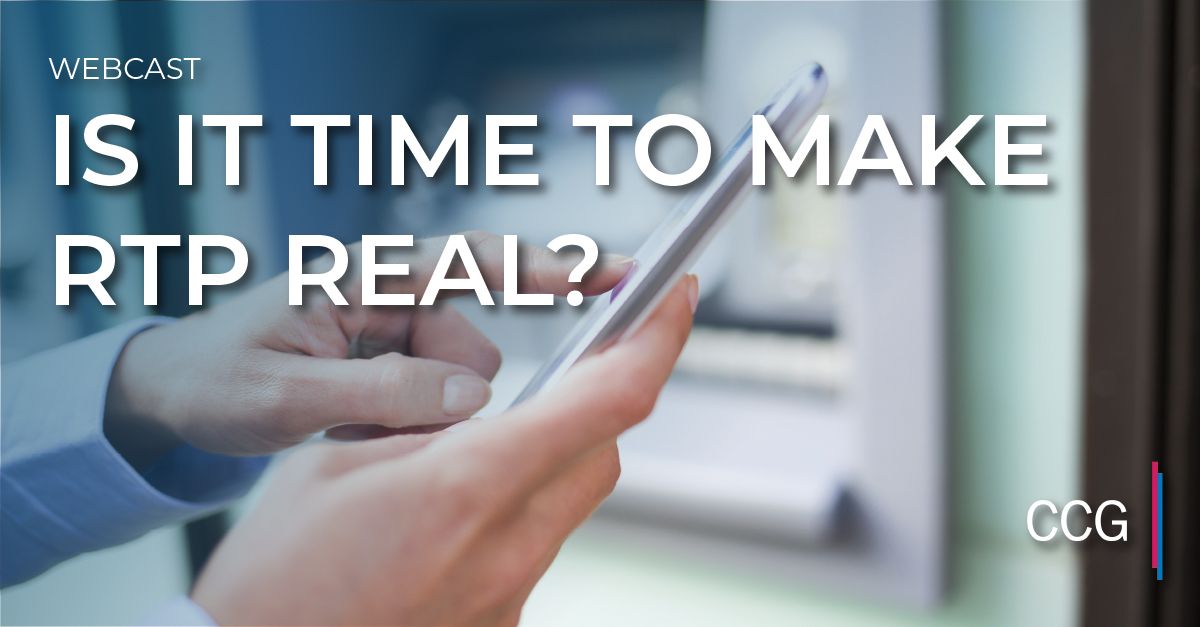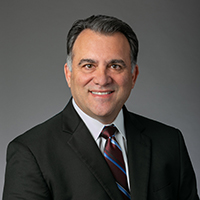Is It Time to Make RTP Real?
Available On Demand – 27 minutes
There is hardly a day that goes by without another announcement on real-time payments. From Zelle, to the Clearing House, to Visa, to MasterCard, and now the Federal Reserve, there is no shortage of announcements and activity. How do financial institutions make sense of it all? Tune into CCG’s Webcast with host Scarlett Sieber, industry veteran John (Mac) Macaluso, and special guest, Fiserv Vice President of Real-Time Payments Tim Ruhe to explore what real-time payments mean for you and your financial institution and what comes after real-time.
Subscribe to CCG Insights.
[restrict]
Scarlett Sieber Welcome back to the CCG Catalyst webcast series. We are back talking about another very fascinating topic this week. We have a very special guest named Tim Ruhe, who is Vice President of Payment Strategy and Partnerships at Fiserv and joined by Tim will be my colleague named John Macaluso, better known as Mac, who is Principal here at CCG. As always, I am Scarlett Sieber, Managing Director and Chief Strategy and Innovation officer here at CCG and I will be your host. So you have already heard about Mac and I having a conversation to get things going as it relates to real time and what that is. We are going to be doing a deeper dive today. And really, what is it? Why is it time now to make real time payments real? And is it real? What does that actually look like? Before we get started, a few housekeeping rules at the bottom of the screen you’re going to see pictures of Tim, Mac and myself. Those are our bios. You can look and see Tim’s full background, Mac’s full background. You will have access to their LinkedIn. You can connect with them on there. To the right, you have that CCG logo. That is your go to resource for all things CCG. You’ll see recent articles that were published by Mac and myself and some of our colleagues, as well as a bunch of other content that may be relevant to you. And then to your left, you have that Q&A button. Please use that throughout the duration of this conversation. The guys would love to hear from you. There’s a lot of topics that are going on, a lot of thoughts as it relates to this. So please use that if we do not get back to you by the end of the webcast. Do not fear we will get back to you by the end of the day. Alright. So let’s get started. Tim, so nice to have you join us today.
Tim Ruhe Oh, thanks for having me. It’s a pleasure to be here.
Scarlett Sieber Awesome, Mac. As always, partner in crime. Nice to see you again.
John Macaluso Looking forward to this conversation. It’s going to be a great.
Scarlett Sieber OK. Alright. So let’s go ahead and dive in there. There’s hardly a day that goes by. I’m a person who stays up on the news in our space without some other announcement as it relates to real time payments from Zelle to the Clearing House to Visa to MasterCard to the Federal Reserve. There’s just a lot. So I’m curious, Tim, how do you make sense of it all and really get through the noise?
Tim Ruhe Yeah, there is a lot going on. There are a lot of options, but I think it starts with what you’re trying to accomplish as a business and, you know, really there is no substitute for a good plan. So I think the first step is to step back and say, what are the most important capabilities you wanted to deliver to your customers? Because you can real time enable a lot of different things. But you have to decide what are the things that are most important. You know, many FIs have started that with P2P or disbursement. So you have to decide what is the most important thing to do first and then second and then third and then start to think through how you can do that in a way where you’re building on existing infrastructure and trying to create as few new things as possible.
Scarlett Sieber Mac, anything you can add to that?
John Macaluso Yeah, yeah, and that’s what I was going to say and creating that plan. That’s why this one is so exciting to me, because I think we’re going to talk about a lot of good information for banks and credit unions to utilize as they build that plan. I agree with Tim. That is the most critical part about this. Understanding all of the options that are available. Understanding how that fits within the construct of your bank or credit union plan. And then executing. We see many people kind of responding to what’s happening in the industry. Right. If bank ABC does it, I need to do it. But everything doesn’t fit everybody. And that’s what we have an opportunity today. Talk to one of the industry experts who can explain a lot of those, you know, a lot of those very complicated issues. And that will better inform the banks and credit unions on how to build that plan. So I think that’s a great start.
Scarlett Sieber So, appreciate that. And Tim, with a with a title like V.P. of Payment Strategy, you are the brains behind a lot of these things that are happening in the industry. So can you just kind of level set for us what is actually happening today? What exists? What’s real versus hype? Because there’s so much out there. How do we know what is actually happening?
Tim Ruhe Great question. Yeah. There is a fair amount of real time activity starting to happen. We’ve implemented a little over 300 financial institutions and we’re processing a little over two billion dollars’ worth of transactions a month in different real time activity. The top use cases, if we use the word use case a lot. Right. Which sort of translates into the use. Right. So a use case would be interbank transfers or a business to business payment or a person to person payment. So right now, the top uses or use cases for real time is really centered around person to person payments and disbursements. Disbursements tends to be on the commercial banking side of the house. Right. So person to person is that ability for me to send you money instantly. And what’s really driven that is, Zelle. And, you know, Zelle is a national network gaining widespread adoption. And so we’ve been doing a whole lot of implementations of Zelle for our financial institution customers. That coupled with disbursements that we do for both our financial institution customers and our business customers. That’s really making up the bulk of the of the activity today. But everybody’s looking at, you know, where they go next.
Scarlett Sieber And Tim, from the Zelle perspective, I mean, that’s in no way surprising, I guess, in terms of the kind of the hyper growth that we’ve seen. But I’m curious from your perspective, why now for Zelle? Because aspects we can get into kind of a difference between some of the other players, but the PtoP at the high level concept has been around for a while. So why do you think now it’s continuing to grow and is really dominating the market.
Tim Ruhe Yeah, great question. You know it’s actually grown even stronger more recently with COVID. Right. But, you know, people are at a point in their financial lives and their digital lives where, I mean, more of their life is becoming digital. Right. And they start to expect, and I think we can all put ourselves in this category, expect to be able to do things instantly. And the idea that I can’t pay a personal electronically or if I do it takes a long time is just not a good place to be. You had some nonbanks like PayPal and Venmo and Square and Apple introduce person to person payment services that were sort of closed loop and then you could do within those environments that were sort of real time. And it really, you know, the banks took a look at that and said, well, you know, we should be able to do that between the banks and we should be able to make that happen truly instant. So when I send you money, it comes straight out of my bank account instantly and straight into yours instantly. And, you know, the banks got together and put their minds to it and said we are going to introduce true real time P2P payments because these are transactions that consumers would prefer to do at their financial institution. And that’s really how P2P got started as a early win. Right. And so today, what we’re seeing with that, what we’re seeing with P2P, just got to put a finer point on it as we’re seeing over 100 percent growth year over year pretty consistently for the last few years. So clearly it’s catching fire.
Scarlett Sieber Yeah, absolutely, and I think you started hitting on this point in that response, which is you have to respond to the actual needs and demands of the customers. And so some of this when they go in and people are advertising saying this is real time, but then they actually see that the money doesn’t get into their account and they can’t use it until the next day. Well, in many cases, that might not be a big deal. But in plenty of cases, being able to have that money today to go get your car fixed at that moment is actually game changing. So it’s interesting to see that the banks have stepped up there. So, Mac, you know, when we think about what Tim was just talking about and the different players who were in the market and the banks response, does that mean that banks and credit unions are going to need to support multiple networks? And do you think that the existing card networks need to be replaced?
John Macaluso So, you know, the reality is, is that there are exist there are multiple networks. As you and I have talked multiple times through this process. There’s debit networks and then you can call ACA to kind of a network and then there’s the P2P network. So the reality is today there are multiple networks. So, yes, they’re going to have to manage them. But over time, these will synthesize into a single network, a single method or approach. And banks will definitely incorporate that into how they manage them. And when that will occur is as soon as they begin to go to the next step with payments. So what we’re fixing right now is the immediacy of me sending money to you. Right. You sending money to me. We’re fixing that problem. There used to be a delay. We fixed that problem. The next step is where banks say not only is this transaction about Scarlett sending Tim money, this is about me understanding why, when, where Scarlett is sending Tim money so that I can become more integrated into all the other aspects of your life. So we’re moving as soon as we move to the next level, I want to know the data about the transaction. Then we will begin to synthesize or better put maybe homogenize these networks into the ones that can best address that aspect. Today, we’re at step one.
Tim Ruhe Yeah, yeah. And as Mac said, there’s a lot of things that we can all envision wanting to do. Right. The place we’ve started as an industry is really solving this ability to send other people money instantly. And I would point out it’s not just about instant, it’s about seven by 24. It’s the ability for me to send Mac money on a Saturday. Right. And not have to wait till Monday to get it or to send him money at, you know, 8:00 p.m. at night. And he gets it right away. To not have cut offs and windows and delays and weekends and all that stuff. So it’s both about the speed of delivery and the seven by 24. But it is going to move way beyond P2P. We’re already seeing a lot of use in disbursements. Right. So I’m looking forward to the time where I’m spending more time getting back into you know Ubers and Lyfts. But, you know, you talk to those drivers and they like to get paid right away. When they do a ride, then they want instant cash out. Right. So that’s a big use case. Right. And then ultimately, you want to be able to transfer money between accounts instantly and you want to be able to pay bills instantly. Right. And businesses want to be able to pay suppliers instantly and just maybe even more important, get paid faster. Right. So all those things are coming behind, you know, in the coming years as well. Right. It’s just I think financial institutions have started with software and some of the greatest pain point is now as P2P.
Scarlett Sieber That makes that makes a lot of sense, and I think. So let’s talk a little bit more about because we have primarily a bank and credit union executives as part of this. So I want to make sure that we’re trying to give them some helpful things with their hats on. All of this stuff that we’re talking about is so exciting. And I’m very optimistic about the impact that it will have. But of course, with that, there is a big investment on the financial institutions side. Two-part question, how do banks and credit unions keep up and what can they do to reduce the effort in time to market? Because even if they say they’re central strategically and say, hey, we want to be part of this. How do they make sure that this is something that happens in six months as opposed to two years? What can they do to kind of accelerate that?
Tim Ruhe Yeah, what can you do to accelerate? Right. I mean, you want to keep up. Everyone wants to keep up and get to market quickly. And so the good news is there are commercial solutions available to accelerate that. Right. You could take the approach of you’re going to have to build this from the ground up. Most financial institutions, in fact, are not. I mean our, you know, 600 customers for real time are using our turnkey solutions, if you will. Right. They’re processing services where we’ve built a very configurable platform. They can adapt their front end to that platform. Then they avoid doing a lot of the heavy lifting and can get up and running in months instead of years. And also, you know, real time and the networks behind it continue to change at a pretty good clip, meaning there’s a lot of maintenance to do. So when you have your own platform, you end up needing to do a lot of maintenance. If you use a processing service that’s done for you and you can focus on your customer. So there are really good solutions out there. And I happen to be partial to Fiserv. I think we have the best solutions in terms of, you know, turnkey capabilities that can get financial institutions to market quicker or take care of the core integration forum because that’s a key component of real time. You got to integrate to core. So take advantage of that.
Scarlett Sieber Tim, what is it you talked about kind of going from , you know, years to a couple of months in all those examples that you had, because, of course, no financial situation is the same. I’m curious. What was the quickest turnaround time that you saw in getting set up?
Tim Ruhe Yeah, I think a couple months is aggressive. A few months is probably better. Certainly we’ve had implementations in less than six months, which is pretty fast if you consider, you know, that needing to do the back end integration to the core to be able to post these transactions instantly to the account, plus making sure it’s exposed in the front end, certifying with the network. So, you know, generally we’re seeing implementations in the six to 12-month timeframe.
Scarlett Sieber Got it. So, Mac, Tim has been talking, you know, made some allusions to the opportunities and great aspects of the turnkey solution and the connection integration of the core. From your perspective, I know, Mac, both in your previous roles and what you’ve been doing now when you’re talking to these financial service executives around this component, do you think that they need to replace their core banking platforms with the real time core? And what would be the advantages of doing that?
John Macaluso So that’s a pretty simple answer. The answer to that is yes. And the reality is, that the majority of banks in the United States are not processing on real time cores. And in order to compete and that’s really the key for banks and credit unions, now credit unions, for the most part, had been operating under a real time course for a long time. But many of the banks have not. But in order to compete and actually Tim talked about two things, you know, number one, we are today talking a lot about P2P, but we’re absolutely moving to more of real time payments, moving into the business world. And in order for banks to satisfy those business customers, then they need to be on a platform which can satisfy the transaction in real time. So the reality is the large majority of banks in the United States must consider their backend core processing and that backend core processing engine must be real time. Again, we will go through generations of advancement in these technologies. Today, where we are, not having a real time core isn’t as much of an issue as it will be in six months or a year or 18 months, when we move beyond just posting the transaction to looking at the data around the transaction. That’s a tough thing for banks to kind of swallow. But I think most of the core vendors that operate in the United States have some answer to the real time challenge for core backends. So I’m pretty comfortable saying, yes, banks must consider their core process, their core backend processing. And that consideration must be adoption of real time capability.
Scarlett Sieber So another thing there Mac, we’re putting my ex CIO hat on, I can already hear my other team members in risk and compliance and other aspects raising their hands here. So, you know, does because Tim you made an allusion to this at one point in an earlier answer, but does real time payments equal real time fraud? You just talked about the ability to move money right away. So what is the impact on that? Let’s put the kind of negative light on for a second, what is the negative impact potentially for this real time payments mean? And then what can banks and credit you do to protect themselves?
Tim Ruhe Yeah, that you’re right. Faster payments can mean faster fraud. And so you have to protect against that. And you have to be thoughtful. And what we found with our customers is we’ve managed to avoid that problem because we’ve taken the right steps up front. Right. We provide risk management tools so that you can set special limits for real time transactions that you might not set for non real time transactions, because they’re final. They’re done. So you need to set different limits and you might need to set lower limits for some customers at the beginning and grow it over time. So you need to manage those separately. We have the tools for that. We have very specialized and specific what I’ll call use case specific fraud and risk tools. Right. So how you look at and try to detect patterns of fraud and risk in P2P is different than bill pay, is different than transfers, is different than disbursements. So our fraud and risk algorithms are definitely highly tuned to the specific application. And they’ve been tuned over time because we’ve been tuning them for non real time and now we’re adapting them for real time as well. So having tools that adapt to the use case, not just the speed, is a second important step. And then having the built in abilities in your applications to challenge the customer at the right time. Right. There may be certain points at which you’re going to let the transaction go and other points where you want to challenge for an out-of-band authentication. So, you know, you just have to have those capabilities built in. And when you add that up, we’ve found that the incidence of fraud are pretty low. We’ve really avoided, you know, big losses in fraud with most of our customers.
Scarlett Sieber Thank you. That’s helpful. So as we start wrapping up here, I think one really, I always try to look with the futuristic glasses on so I’m curious from both of your perspectives, we’ll start with you, though, Tim. We’re talking a lot about real time. We were talking about the impact on P2P and all these other areas that it’s going to impact even more with disbursements and whatnot. What comes after real time? What is next? As a V.P. of payments strategy? What is your brain thinking about?
Tim Ruhe What comes after real time? Yeah. Where we are starting to see real time with data. So data with payments, money plus information. Right. Transactions are moving to interactions. Right. What do we mean by that? For example, today we think about making a payment. Right. I pay a bill in the future. We’re going to be moving more and more to. I don’t just wake up and decide to pay a bill. I get a request for payment. I make the payment and I get a confirmation. Right. And we’ll start to see that. Zelle has that feature as well. You can request the payment. I can request a payment from you and then you pay it. So that becomes more of a real time interaction payment with data. And so those are the things we’re doing. And we have built those capabilities and have scaled those capabilities in many of our applications already. And I think, you know, that ability to leverage data and making payments smarter will be critical for success in the future.
John Macaluso Absolutely. Absolutely.
Scarlett Sieber I like the moving from transaction to interaction. Good tweetable moment there. Yeah I mean, really what you’re saying is especially because I like to always look at it from the lens of the end consumer of said services is that you’re through data it’s going to be more naturally integrated into their lives and their behaviors. So just kind of makes more sense, which is awesome. OK. We have time for one audience question before we go here. So let me just get to that. We have and this is for either of you. What do you make of the Fed entering the market with plans to support another network Fednow?
John Macaluso Tim, what are your thoughts?
Tim Ruhe Well, I guess it’s not too surprising, really. I mean, the Fed and the clearinghouse both provide ACH processing today and most of our payment now, all of our payment networks in the US are not sole source. Right. We have, you know, sort of a you know, a very capitalistic approach. And competition is good sort of philosophy in the US. So seeing the Fed come in the way they do with ACH is really not a surprise. I believe there will be a high degree of interoperability between what they’re doing and others. And I think there were a lot of stakeholders in the industry, you know, asking them to come in. So, you know, I think we’re pretty good in the industry about, you know, managing different networks. And so I think this will just become part of what we do behind the scenes. Mac, your thoughts?
John Macaluso You know, just to add. I think the as always, there is a concern when private organizations like Zelle, like Fiserv, create these payment networks. And there’s a concern on the banks and the credit unions, the 8,000 or so that exist, said hey, do we want a private organization to kind of control this? Fed now gives that, you know, gives them another option. I’m not sure it’s as much of a concern to me. I look at it as an advantage. I think it’s just a natural evolution of all of this. But I can see the concern. I hear when I talk to banks. Right. You know, am I going to be tied to Zelle? That’s a private company versus is the Fed going to be able to come in and do some of that? Shouldn’t they be doing that? And I understand that I am less concerned because I think these are good people running these networks that are well intended and understand the value of the network, which means everybody has to play. But it’s good. I think it’s good that the Fed is getting into it. I think it’ll mitigate some concerns.
Scarlett Sieber All right. Well, with that, thank you both so much, appreciate you taking the time. To all of you, as always, thanks for joining us. If we do not get to your question, we will do our best to respond right now. If not, we will definitely respond by the end of the day. For those of you watching on demand, you can feel free to reach out to us at a later time as well. We would love to have those conversations with you. Please do not forget to use those resources at the bottom of the screen. They are there for you. If you have other thoughts on things you’d like us to cover as relates to real time payments for their thoughts for Tim, Mac or myself. Please let us know, you know how to get in contact with us. Guys, once again, thank you so much. Appreciate the time. And for everyone else.
Tim Ruhe Thanks, Scarlett.
Scarlett Sieber Thank you.
John Macaluso Thanks Scarlett. Thanks Tim.
Tim Ruhe Alright, see ya.
[/restrict]
Is It Finally Time for Open Banking’s Debut in America?
Digital Dreams – Expanding Commercial Banking Capabilities
Over the COVID Horizon, Mobile Banking Demands Strategic Clarity
Chief Strategy & Innovation Officer Scarlett Sieber is one of the world’s premier voices in financial services. She is among the industry’s most sought-after speakers as a thought leader and innovator with expertise in driving organizational change at both startups and enterprises across the financial services and fintech ecosystem. Scarlett has been invited to speak at over 100 prestigious financial services and technology conferences globally, including Money20/20, Finovate, South Summit, and NASA’s Cross Industry Innovation Summit.
Scarlett’s experience includes founding her own startup as well as working at banks such as BBVA, USAA, and Opus Bank. She is a leading fintech influencer, included on lists such as Top 100 Women in Fintech 2019 and Top 10 Fintech Influencers in the U.S. Scarlett also has deep experience in digital strategy and innovation implementation, making her a key asset to building cutting-edge programs for our clients.
As Principal of our Technology Strategy, John Macaluso has built a reputation within financial services as a trusted advisor to banks and fintechs. With over 30 years of proven leadership, John’s experiences include all areas of information technology, business planning, innovative solution design & deployment, business & operational leadership and business & technology transformation. John advises a vast area of technology within financial services from fintech startups to established global financial institutions. Specialties include digital transformation to established core technologies.
Previously, John held senior roles at Fiserv (a fortune 500 company) driving large-scale change from multi-channel to traditional and non-traditional banking services, national to international markets. Additionally, he served as a CIO for the MLB New York Yankees diving innovation and technology to major league baseball.
As Fiserv’s Vice President of Payment Strategy and Partnerships, Tim Ruhe is responsible for ensuring the long-term success of Fiserv and its clients through innovative partnerships and product co-creation. This includes partnerships in real-time payments and data-driven payment experiences across both Consumer and Commercial Payments.
Prior to his current role Tim held multiple product development and innovation leadership positions at Fiserv, which has included leading Fiserv’s entry into real-time payments, P2P payments, and mobile banking.
Prior to joining Fiserv, Tim he held leadership positions at CheckFree, Corillian, and Rational Software.









